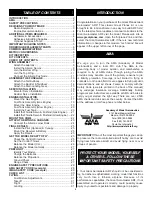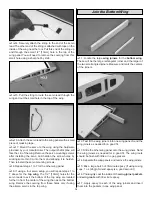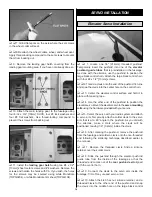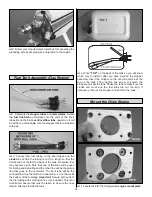
❏ ❏
10. Center the servo using your radio system and
attach the pushrod to the servo arm and control horn. If the
aileron is not at neutral, adjust the clevis to trim the aileron.
Tighten the 4-40 hex nut against the back of the screw
clevis. Use a drop of Threadlocker to prevent the nut from
backing off.
❏ ❏
11. Trim off any unused servo arms.
❏
12. Repeat this process for all remaining aileron pushrods.
❏
1. Using a sharp hobby knife, remove the covering from
the elevator and fin mounting slots in the rear of the
fuselage. Also, if you have not already done so, remove the
elevators from the horizontal stabilizer.
❏
2. Slide the stabilizer into the fuselage.
❏
3. Check the alignment of the stabilizer. The stabilizer
should be parallel with the flat surface. If it isn’t, sand the
slot in the fuselage as needed to make it level.
❏
4. Insert a T-pin into the fuselage near the nose and
along the centerline. Attach a piece of non-elastic string,
such as kite string or Kevlar
®
thread, to the T-pin that is long
enough to reach the stabilizer. Measure the distance from
the T-pin to the outside TE of the stabilizer as shown in the
sketch in step 4 above. Adjust the stabilizer until these
distances are equal.
❏
5. Once the stabilizer is properly aligned, trace the
outline where it enters the fuselage on the top and bottom
of the stabilizer using a fine-point marker such as a Panel
Line Pen (TOPQ2510).
❏
6. Remove the stabilizer from the fuselage. Use a sharp
hobby knife or the following
Expert Tip to remove the
covering 3/32" [2.4mm] inside the marks you made on both
Attach the Tail Surfaces
ASSEMBLE THE FUSELAGE
13














































